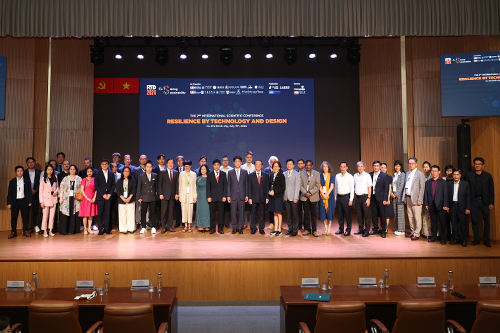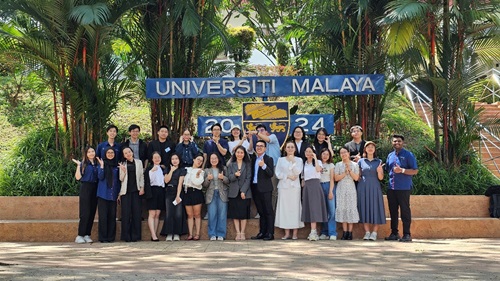![[Podcast] Developing Digital Human Resources in the Current Vietnamese Enterprises](/images/upload/img_background/ueh-bg-093404-072523.png)
[Podcast] Developing Digital Human Resources in the Current Vietnamese Enterprises
The Fourth Industrial Revolution (Industrial Revolution) is creating a rapid change in terms of the way of management, administration as well as the development process of enterprises. This trend may disrupt the labor market as artificial intelligence is gradually replacing human labor in the economy upon automation in various fields and stages, resulting in the consequence that millions of workers around the world fall into unemployment. This is as one factor that directly affect the trend of developing digital human resources, especially in today’s businesses.

Issues regarding digital human resource development within the situation of the Fourth Industrial Revolution
In the economic structure, human resources have a dialectical relationship with the production means. The more the economy develops, the higher the requirements for the quality and the qualifications of human resources become. Moreover, people are not merely an element of the production and business process; rather, a valuable resource of organizations and enterprises. Enterprises move from saving labor costs for cost reduction to investing in digital human resources for a more competitive advantage and efficiency with higher profits. The Fourth Industrial Revolution is the fundamental condition and foundation for the economy to transform strongly from a broad-based growth model (based on resources and low-cost labor) to a model of in-depth growth (based on the knowledge economy, digital economy and high-tech labor) (1). In order to successfully transform Vietnam’s economy to a digital economy, it is necessary to have digital human resources - the main force to deploy and realize the digital economy - that decide the existence of the digital economy with the capacity to master digital technology devices and to be operated in the production, business and other activities of the economy.
From a macro perspective, the digital economy is mainly in accordance with thedigital technologies, in which economic activities use digital information and digital knowledge as the main production factor. However, any country in the development process towards a digital economy is a long process and digital transformation on the national level at different degrees.
From a micro perspective, in accordance with management theory, an enterprise’s infrastructure includes four important factors: human, processes, organizational structure and technology. When one of those 4 factors changes, the other factors will be affected and altered, creating a new equilibrium for the business. In terms of the impact of the Fourth Industrial Revolution, digital human resources - one of the four important components that will change a lot – is to focus on some core changes as follows:
Firstly, human resource management relies on technology and efficiency. HR professionals integrate HR functions faster, acting directly alongside functions in operations. The interconnected work model using information technology has blurred the line between the physical office and where the work actually takes place. Digital human resources focus more on specialized high-value-added work groups. Businesses are in the process of replacing jobs, reducing human resources by using digital technology, integrating technologies (from email, instant messaging and enterprise social media tools to HR applications and virtual meeting tools); consequently, human resource management must be based on digital technology. The organizational structure of the enterprise’s personnel tends to be more open and shared. The relationship between enterprises and employees will change from being legally binding (under the form of a contract) to being binding on a commitment concerning working performance and the principle titled ‘sharing work, sharing profit’. It is explainable because technology allows to measure, to calculate and to identify specifically the contribution between businesses and employees in the actual time.
Secondly, quantifying human resource work and trending building big data. Problems in human resources have been difficult to be quantified through data listed as employee engagement, development ability, and job satisfaction. Currently, through big data and digital technologies, businesses can digitize these issues.
Thirdly, this is being the era of Artificial Intelligence (AI) application. Along with big data is artificial intelligence in digital human resource management. AI combined with big data will replace human resources, listed as recruitment, evaluation, training, development and employee engagement. AI helps HR professionals focus on work with greater added value. In a digitally equipped HR team, administrators can manage the uploads and downloads of complex data packages that accompany talent assessments and reward decisions in a fully automated process. AI can also oversee the screening of internship and graduate applicants through online numerical, logical, and cultural tests in a consistent, efficient manner.
The status of digital human resource management in the current Vietnamese enterprises
Calculated until July 31, 2022, Vietnam has a population of more than 99 million people, ranking 15th in the world and 3rd in Southeast Asia. The working-age workforce in 2021 is estimated at 50.5 million people. Laborers who have been trained at elementary level or higher in 2021 are estimated at 13.1 million people, accounting for 26.1%, up 0.8 % points higher than that of the previous year (2). This is one of the favorable conditions of Vietnam during the Fourth Industrial Revolution. The number of human resources is large and abundant while the quality of Vietnam’s digitally trained human resources can be considered as strengths. Among more than 13 million human resources with primary vocational training or higher, more than 5 million people obtain university degrees or higher, accounting for 44%. This is an important factor for Vietnamese human resources to transform and to adapt to digital technology. On the other hand, developing countries are facing some challenges upon approaching the Fourth Industrial Revolution, namely the shortage of skilled digital human resources. In accordance with the data in the Report on Readiness for Future Manufacturing 2018 of the World Economic Forum (WEF), Vietnam ranks in the last group in terms ranking highly-skilled workers, 81 out of 100, after Thailand and the Philippines in the group of ASEAN countries (4). To be more specific, the current situation of digital human resource management of Vietnamese enterprises in the Fourth Industrial Revolution is as follows:
In terms of human resource planning: Very few enterprises make long-term human resource planning. Moreover, in the human resource development strategy, the determination of labor surplus or shortage needs to consider both the micro-perspective in parts of the enterprise and the macro-perspective on human resources within the local, regional and national scopes. In particular, the COVID-19 pandemic has affected economic development, production and business activities of enterprises and employees. In accordance with the survey results, in 2021, 52.66% of enterprises have unchanged employees compared to the fact that, in 2019, 13.19% of enterprises witness the increase in employees and 34.15% of enterprises face the decrease in employees. In which, enterprises applying forms for employees to take time off and alternate leave accounted for 31.77%, employees with salary deferred accounted for 31.43%, employees on temporary leave without pay accounted for 7.94% and 28.86% of employees quit or lost their jobs. Facing difficulties caused by the impact of the epidemic, businesses have changed their business methods and applied some response solutions listed as: 26.69% of enterprises tend to seek new product consumption markets; 23.89% of enterprises changed services and products supplied to the market; 22.09% of enterprises apply e-commerce in production and business activities; 15.42% of enterprises seek new input material markets and 11.91% of enterprises invest in equipment and technology (5). Therefore, human resource planning is mainly short-term, not focusing on the long-term.
In terms of job analysis: Enterprises in Vietnam carry out the construction of job positions and job analysis. Each enterprise has its own templates for drafting job descriptions, including main contents listed as: Job title; Name of the in-charge Department; Supervisor’s name; Brief job description; Job completion standards and so on. Nevertheless, the current job analysis of enterprises is mainly carried out by the Unit Heads. In the current digital technology era, the human resource management department can apply AI in performing job analysis, both ensuring objectivity and optimizing work efficiency.
In terms of human resource recruitment: Digital human resource management, currently, is to perspective that job seekers and employers register on business websites or job search sites. Therefore, the recruitment of workers sometimes does not guarantee the right employment to meet the needs of the employer. Moreover, because the recruitment process of many enterprises is not associated with evaluation and learning and often performed by a department or group, many cases of selection do not completely meet the requirements. Therefore, the recruitment needs to be combined with a technical parameter box to filter resumes, both simplifying the recruitment process and easily selecting the human resources that meet the requirements of the employer.
In terms of job performance evaluation: Most enterprises use the scoring method, however, the evaluation criteria, often being subjective, are not based on the job description. Currently, very few enterprises apply the assessment of superiors by employees. This will reduce the objectivity in the evaluation, resulting in the fact that many managers are unwilling to learn and to innovate themselves. In order to develop digital human resources, it is necessary to manage human resource information so that enterprises can know the causes and the cases of job change and leave, thereby, solving the root of the problem, improving the work attitude and working quality of employees.
In terms of training and retraining: Currently, the training and the improvement regarding working skills and personal skills for employees to keep up with the development of science and technology are being isolated and fragmented in enterprises. There has been no training and development strategy associated with specific visions and goals; actually, mainly only investing in improving senior managers’ and experts’ qualifications. Regarding the training for technicians and workers, it is mainly self-training or workers have to improve their skills by themselves. The efficiency of the use and the management of human resources in Vietnamese enterprises has been being low, unable to meet the rapid development of the economy as well as the current requirements concerning using human resources.

The fact that human resources obtain University degrees or higher accounting for 44% of the total number of human resources in Vietnam is an important factor for Vietnamese human resources to transform and to adapt to digital technology (Image: UEH)
Some solutions to promote the development of digital human resources for the current Vietnam
Firstly, enterprises need to set up a human resource apparatus adapted to high technology, especially at the senior management level. Enterprises need to promote the use of employee management software to administer and to assign work to prevent cross-work and to help business managers control and assign tasks simply, quickly, accurately and efficiently.
Secondly, pay morre attention to talent selection. In addition to professional capacity, talents must have an open vision and be ready to integrate and communicate in multi-modalities. It is necessary to have a recruitment process that takes “interpretation of integration” action in parallel with the professional probation assessment, listed as contacting the probationers for “interviews”, monitoring during the 2-month probationary period to value how they have understood and felt about the business, listening to their thoughts to add to the values of the enterprise. If they understand something in the wrong way or have any questions, it is an opportunity to help them understand and behave better. Through an integration test to ensure that employees have an acceptable understanding of the enterprise, culture, core values and business ethics standards to have the right mindset and attitude. If a probationary employee achieves professional qualifications but fails to pass the integration awareness assessment, the human resources department has the right to propose the leader to extend the probationary period in accordance with the Labor Law. This is an opportunity to “correct mistakes” for the initial recruitment to ensure that: ‘recruitment’ means ‘to find’ the right resources with the right skills, professional knowledge and attitudes suitable for the business.
Thirdly, develop internal personnel training. Enterprises need to improve the training and the development of internal digital human resources. This issue, currently being focused by many businesses, is considered a factor to improve competitiveness. Enterprises are willing to invest cost and time for this work by sending personnel to study domestically and internationally to improve professional qualifications and management capacity. Many businesses invite an independent consultant or advisor to train key staff towards directly acquiring knowledge and practical ways to apply to the organization’s activities. In addition, enterprises must identify key employment positions, backup people and select suitable successors to have a specific action plan and to build a succession team.
Fourthly, improve the way of “keeping people”. Recruitment, training and developments towards digital human resources in enterprises cannot avoid risks. Therefore, in parallel with this work, enterprises need to improve reasonable human resource policies to maintain employee quantity and quality. Therefore, in addition to maintaining good welfare regimes, enterprises need to form a reasonable decentralization and authorization system so that management levels can be autonomous in their work, thereby, helping leaders have more time for strategic planning while still being able to control the operation. In the long run, it can be directed to the division of profits and share ownership among employees to align personal interests with the interests of the organization.
Fifthly, automate the mechanism for digital human resource development. With the advantage of the Fourth Industrial Revolution, enterprises need to apply the values of technology in an effective manner. This means that businesses need to automate digital human resource management. Digital human resource development software brings comprehensive management solutions to businesses, making the enterprise’s human resource management process easy and highly effective, reducing costs and task execution time; especially helping leaders quickly make the right decisions related to personnel.
Author: Dr. Pham Thi Kien – UEH School of Social Sciences. This is an article in the series of articles spreading research and applied knowledge from UEH with the “Research Contribution For All - Nghiên Cứu Vì Cộng Đồng” message, UEH cordially invites readers to watch the next Newsletter ECONOMIC No #58.
News, photos: Author, UEH Department of Marketing and Communication
Voice of: Ngoc Quy


![[Podcast] Does the Financial Flexibility Prevent Stock Price Crash Risk during COVID-19 Crisis? Evidence from the Vietnamese Stock Market](https://en.ueh.edu.vn/images/upload/thumbnail/ueh-thumbnail-114718-071624.png)
![[Podcast] An Evaluation Of Two Business English Course Books, Business Partner B1+ Business Partner B2: Students’ And Teachers’ Perspectives](https://en.ueh.edu.vn/images/upload/thumbnail/ueh-thumbnail-113649-071624.png)


![[Podcast] Latest approaches for sustainable universities](https://en.ueh.edu.vn/images/upload/thumbnail/ueh-thumbnail-042022-071224.png)